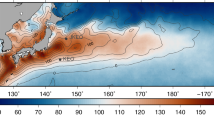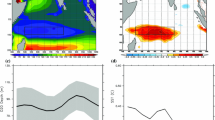Abstract
The responses of sea surface temperature (SST) in the western equatorial Pacific warm pool to the westerly wind bursts (WWBs) play an important role in the relationship between WWB and ENSO. By using data collected from eight buoys of TOGA (Tropical Ocean-Global Atmosphere)- COARE (Coupled Ocean-Atmosphere Response Experiment), the heat balances of the upper ocean in the western equatorial Pacific around 0°, 156°E during two WWB events were calculated according to Stevenson and Niiler’s (1983) method. In both events, SST increased before and after the WWBs, while decreased within the WWBs. The SST amplitudes approximated to I °C. Although sometimes the horizontal heat advections may become the biggest term in the heat balance, the variation of SST was dominated by the surface heat flux. On the other aspect, some different features of the two events are also revealed. The two cases have different variation of mixed layer depth. The depth of mixed layer is almost double in the first case (35 m to 70 m), which is caused by Ekman convergence, while only !Om increments due to entrainment in the second one. There are also differences in the currents structure. The different variations of thermal and currents structure in the mixing layers accounted for the different variation of the heat balance during the two events, especially the advection and residue terms. The seasonal variation of SST in this area is also investigated simply. The first WWB event happened just during the seasonal transition. So we considered that it is a normal season transition rather than a so-called anomaly. That also suggested that the seasonal distinction of the WWB is worthy of more attention in the researches of its relationship to ENSO.
Similar content being viewed by others
References
Cronin M. F., and M. J. McPhaden, 1997: The upper ocean heat balance in the western equatorial Pacific warm pool during September-December 1992. J. Geophys. Res., 102, 8533–8554.
Fairall, C., E. F. Bradley, D. P. Rogers, J.B. Edson, and G. S. Young, 1996: Bulk parameterization of air-sea fluxes for Tropical Ocean-Global Atmosphere Coupled-Ocean Atmosphere Response Experiment algorithm. J. Geophys. Res., 101, 3747–3764.
Feng, Ming., P. Hacker, and R. Lukas, 1998: Upper ocean heat and salt balances in the response to a westerly wind burst in the western equatorial Pacific during TOGA-COARE. J. Geophys. Res., 103, 10289–10311.
Fung, I. Y., D. E. Harrison, and A. A. Lacis, 1984: On the variability of the net longwave radiation at the ocean surface. Rev. Geophys., 22, 177–193.
Godfrey J. S. et al., 1998: Coupled Ocean-Atmosphere Response Experiment (COARE): A interim report. J. Geophys. Res., 103, 14395–14450.
Harrison, D. E., and B. S. Giese, 1991: Episodes of surface westerly winds as observed from islands in the western tropical Pacific. J. Geophys. Res., 96(suppl.), 3221–3237.
Kessler, W. S., M. J. McPhaden, and K. M. Weickmann, 1995: Forcing of intraseasonal Kelvin waves in the equatorial Pacific. J. Geophys. Res., 100, 10613–10631.
Kiladis, G.N., G.A. Meehl, and K.M. Weickmann, 1994: The large scale circulation associated with westerly wind bursts and deep convection over the western equatorial Pacific. J. Geophys. Res., 99, 18527–18544.
Luther, D. S., D. E. Harrison, and R. A. Knox, 1983: Zonal winds in the central equatorial Pacific Ocean and El Niño, Science, 222, 327–330.
McPhaden, M. J., 1993: TOGA-TAO and the 1992–93 El Niño-Southern Oscillation event. Oceanography, 6, 36–44.
Nakazawa, T., 1988: Tropical super clusters within intraseasonal variations over the western Pacific. J. Meteor. Soc. Japan, 66, 823–839.
Niiler, P. P., and E. B. Kraus, 1997: One-dimensional models of the upper ocean, in Modelling and Prediction of the Upper Layers of the Ocean, edited by E. B. Kraus, Pergamon, Tarrytown, N. Y. 143–172.
Ralph, E. A., K. Bi, P. P. Niiler, and Y. du Penhoat, 1997: a Lagrangian description of the western equatorial Pacific response to the wind burst of December 1992: Heat advection in the warm pool. J. Climate., 10, 1706–1721.
Sadler, J., M.A. Lander, A.M. Hori and L.K. Oda, 1987: Tropical marine climatic atlas, Volume II, Pacific Ocean, UHME87-02, Department of Meteorology, University of Hawaii, 27 pp.
Sirgel, D. A., J.C. Ohlmann, L. Washburn, R.R. Bidigare, C. T. Nosse, E. Fields and Y. Zhou, 1995: Solar radiation, phytoplankton pigments and the radiant heating of the equatorial Pacific warm pool. J. Geophys. Res., 100, 4885–4891.
Stevenson, J. W., and P. P. Niiler, 1983: Upper ocean heat budget during the Hawaii-to-Tahiti shuttle experiment. J. Phys. Oceanogr., 13, 1894–1907.
Zhang Chidong, 1996: Atmospheric intraseasonal variability and mean values of the surface meteorology and air-sea fluxes in the western equatorial Pacific Ocean. J. Atmos. Sci., 53, 739–758.
Author information
Authors and Affiliations
Additional information
This work was co-supported by the National Key Project (Grant No. 96-908-02-03), the National Natural Science Foundation of China (Grant No. 4982-3002) and Chinese Academy of Sciences under Grant “Hundred Talents” for “Validation of Coupled Climate models”
The Chinese version of this paper has been accepted by Chinese Journal of Atmospheric Sciences.
Rights and permissions
About this article
Cite this article
Hailong, L., Xuehong, Z. & Wei, L. The Heat Balance in the Western Equatorial Pacific Warm Pool during the Westerly Wind Bursts: A Case Study. Adv. Atmos. Sci. 18, 882–896 (2001). https://doi.org/10.1007/BF03403510
Received:
Published:
Issue Date:
DOI: https://doi.org/10.1007/BF03403510




